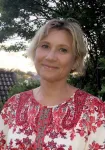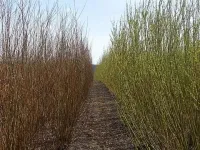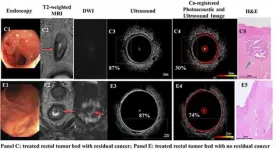The brain area with which we interpret the world
2021-03-26
(Press-News.org) Usually, the different areas in the cerebrum take on a very specific function. For example, they process our movements or things we see or hear, i.e. direct physical information. However, some areas of the brain come into play when dealing with more advanced mental tasks. They process incoming information that has already been pre-processed and is thus already at an abstract level.
It was already known that the inferior parietal lobe (IPL) is one of these regions in the human brain. Nevertheless, it was unclear how this area is able to process such very different functions. In a large study, scientists from the Max Planck Institute for Human Cognitive and Brain Sciences (MPI CBS) in Leipzig and McGill University in Montreal have helped to solve this question. According to their findings, the different parts of the IPL specialize in different cognitive functions - such as attention, language, and social cognition, with the latter reflecting the ability for perspective taking. At the same time, these areas work together with many other brain regions in a process-specific way. When it comes to language comprehension, the anterior IPL in the left hemisphere of the brain becomes active. For attention, it is the anterior IPL in the right side of the brain. If, on the other hand, social skills are required, the posterior parts of the IPL in both hemispheres of the brain spring into action simultaneously. "Social cognition requires the most complex interpretation," explains Ole Numssen, first author of the underlying study, which has now been published in the journal eLife. "Therefore, the IPLs on both sides of the brain probably work together here."
Moreover, these individual sub-areas then cooperate with different regions of the rest of the brain. In the case of attention and language, each IPL subregion links primarily to areas on one side of the brain. With social skills, it's areas on both sides. Again, this shows that the more complex the task, the more intensive the interaction with other areas.
"Our results provide insight into the basic functioning of the human brain. We show how our brains dynamically adapt to changing requirements. To do this, it links specialized individual areas, such as the IPL, with other more general regions. The more demanding the tasks, the more intensively the individual areas interact with each other. This makes highly complex functions such as language or social skills possible," says Ole Numssen. "The IPL may ultimately be considered as one of the areas with which we interpret the world."
Even in great apes, Numssen says, brain regions that correspond to the IPL do not only process purely physical stimuli, but also more complex information. Throughout evolution, they seem to have always been responsible for processing increasingly complex content. However, parts of the IPL are unique to the human brain and are not found in great apes - a hint that this region has evolved in the course of evolution to enable key functions of human cognition.
The researchers from Leipzig and Montreal investigated such brain-behavior correlations with the help of three tasks that the study participants had to solve while lying in the MRI scanner. In the first task, they had to prove their understanding of language. To do this, they saw meaningful words such as "pigeon" and "house", but also words without meaning (known as pseudowords) such as "pulre", and had to decide whether it was a real word or not. A second task tested visual-spatial attention. For this task, they had to react to stimuli on one side of the screen, although they expected something to happen on the other side. The third task probed their ability for perspective taking using the so-called Sally Anne test. This is a comic strip consisting of four pictures in which two people interact with each other. A question in the end could only be answered correctly if the study participants were able to put themselves in the shoes of the respective persons.
INFORMATION:
[Attachments] See images for this press release:

ELSE PRESS RELEASES FROM THIS DATE:
2021-03-26
During a normal waking state, information is processed and shared by various parts within our brain to enable flexible responses to external stimuli. Researchers from the University of Turku, Finland, found that during hypnosis the brain shifted to a state where individual brain regions acted more independently of each other.
"In a normal waking state, different brain regions share information with each other, but during hypnosis this process is kind of fractured and the various brain regions are no longer similarly synchronised," describes researcher Henry Railo from the Department of Clinical Neurophysiology at the University of Turku.
The finding shows that the brain may function quite differently ...
2021-03-26
Scientists at the University of Bonn and the caesar research center have isolated a molecule that might open new avenues in the fight against SARS coronavirus 2. The active ingredient binds to the spike protein that the virus uses to dock to the cells it infects. This prevents them from entering the respective cell, at least in the case of model viruses. It appears to do this by using a different mechanism than previously known inhibitors. The researchers therefore suspect that it may also help against viral mutations. The study will be published ...
2021-03-26
Researchers have demonstrated that stretching shape-memory polymers embedded with clusters of gold nanoparticles alters their plasmon-coupling, giving rise to desirable optical properties. One potential application for the material is a sensor that relies on optical properties to track an object or environment's thermal history.
At issue is a stretchable polymer embedded with gold nanospheres. If the material is heated and stretched, followed by cooling to room temperature, the material will hold its stretched shape indefinitely. Once reheated to 120 degrees Celsius, the material returns to its original shape.
But what's really interesting is that the gold nanospheres are not perfectly dispersed in the polymer. ...
2021-03-26
A recent study published in JCI found that a neutrophil's endoplasmic reticulum, the organelle that normally makes proteins in the cell, becomes stressed in the autoimmune disorder lupus. This stress activates a molecule called IRE1α, which appears to play a critical role in lupus pathogenesis in mice.
A multidisciplinary research group at the University of Michigan, spanning microbiology, dermatology and rheumatology, discovered that IRE1α orchestrates the release of neutrophil extracellular traps, or NETs, from lupus neutrophils. NETs are sticky, spider web-like structures that cause inflammation when released at the wrong time or in the ...
2021-03-26
Research has found that obesity and mental disorders such as depression and anxiety seem to often go hand in hand. Researchers at Baylor College of Medicine and collaborating institutions are providing new insights into this association by identifying and characterizing a novel neural circuit that mediates the reciprocal control of feeding and psychological states in mouse models.
Similar to human patients, mice that consumed a high-fat diet not only became obese, but also anxious and depressed, a condition mediated by a defective brain circuit. When the researchers genetically ...
2021-03-26
Reactive oxygen species (ROS) cause oxidative stress at the cellular level. Research shows that this way, amongst others, they inhibit the germination capacity of plants, produce cytotoxins or exert toxic effects on aquatic invertebrates. Environmentally persistent free radicals (EPFR) are potential precursors of ROS because they can react with water to form these radical species. "Therefore, EPFR are associated with harmful effects on the ecosystem and human health," explains Gabriel Sigmund, the lead investigator of the study.
"Our study shows that these environmentally persistent free radicals ...
2021-03-26
Colorectal cancer risk does not rise after bariatric surgery, a study from the University of Gothenburg shows. This finding is important for patients with obesity, and their healthcare professionals, when deciding upon such an operation.
Obesity is a known risk factor for several types of cancer, including colorectal cancer (affecting the colon or rectum). It is already established that bariatric surgery leads to a decrease in overall cancer risk in patients with obesity.
However, some studies on colorectal cancer have shown an elevated cancer risk after bariatric surgery, while others have reported a risk reduction. ...
2021-03-26
The immune systems of all vertebrates contain specialized cells, called T cells, that play a fundamental role in protecting against fungal, bacterial, parasitic and viral infections. T cells use 'molecular sensors' called T cell receptors (TCRs) on their surface that can detect and eliminate the invading pathogens. For most of the past four decades, it was considered that there were only two T cell lineages, αβ and γδ T cells, characterized by their cell surface expressed αβ and γδ TCRs, respectively.
In a paper published today in Science, an international team of scientists at the University of New Mexico (US), Monash University (Australia), and the US National Institutes of Health, has defined a novel T cell lineage, called γμ ...
2021-03-26
Renewable energy demand and consumption is at an all-time high in the United States.
Shrub willow - a quick-growing woody crop - can be an excellent source of renewable bioenergy. The crop is harvested and turned into wood chips, which can be used for heat, mulch, animal bedding, biochar, and biofuel.
In a new study, researchers grew shrub willow on a semi-commercial scale to better understand the nuances of this bioenergy crop. The research was published in Agronomy Journal, a publication of the American Society of Agronomy.
"We learned and developed key know-hows that we can transfer to industry partners interested in this crop," says Armen Kemanian. Kemanian is a member of the American Society of Agronomy and is the ...
2021-03-26
Rectal cancer, along with colon cancer, is the third-most common type of cancer in the United States, and treatment and surgery greatly affect the quality of life of patients. A multi-disciplinary team at Washington University in St. Louis has developed and tested an innovative imaging technique that is able to differentiate between rectal tissues with residual cancers and those without tumors after chemotherapy and radiation, which could one day help to avoid unnecessary surgeries in some patients who have achieved complete tumor destruction after chemoradiation.
Quing Zhu, PhD, professor of biomedical engineering at the McKelvey School of Engineering, and members of her lab developed ...
LAST 30 PRESS RELEASES:
[Press-News.org] The brain area with which we interpret the world





